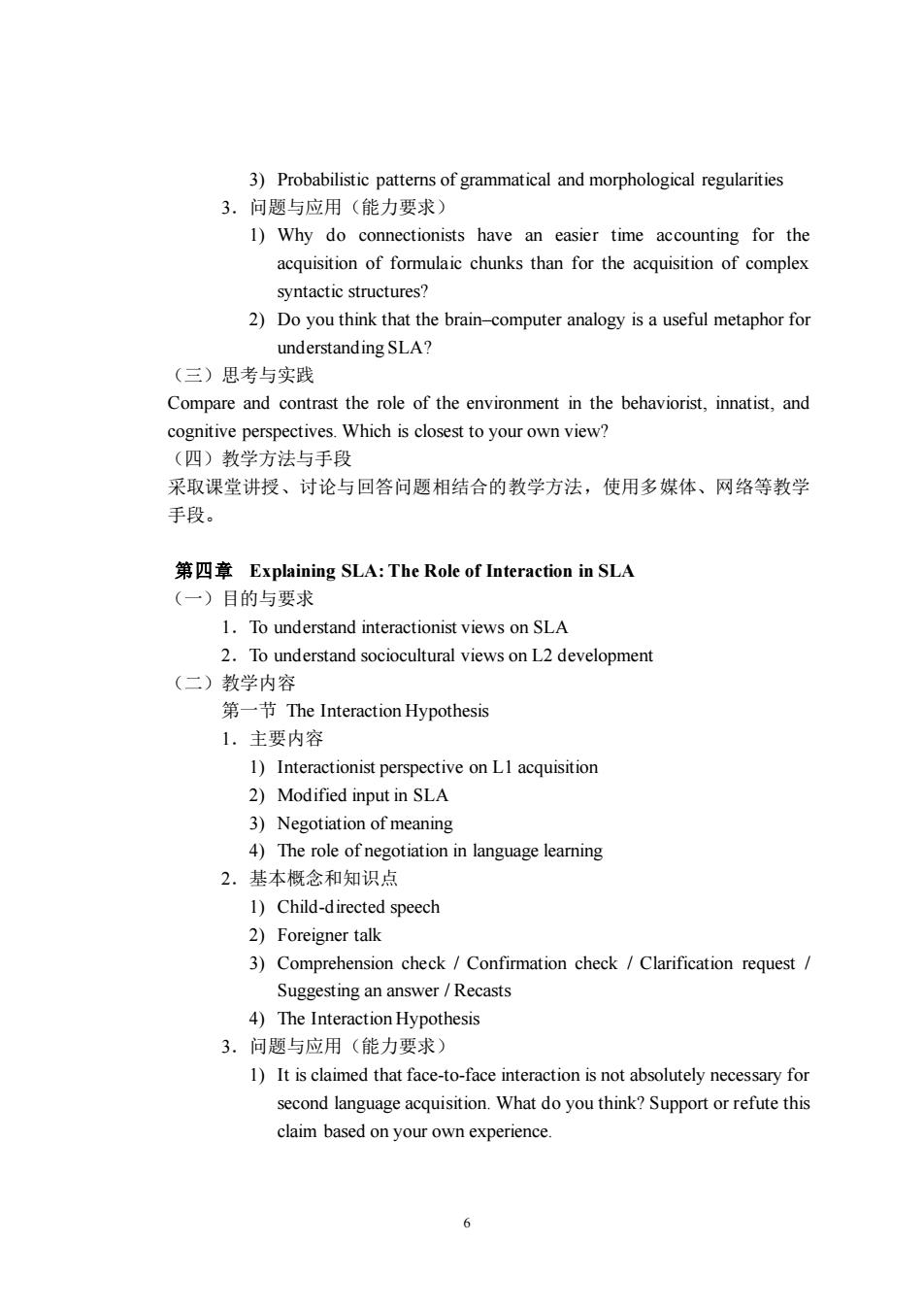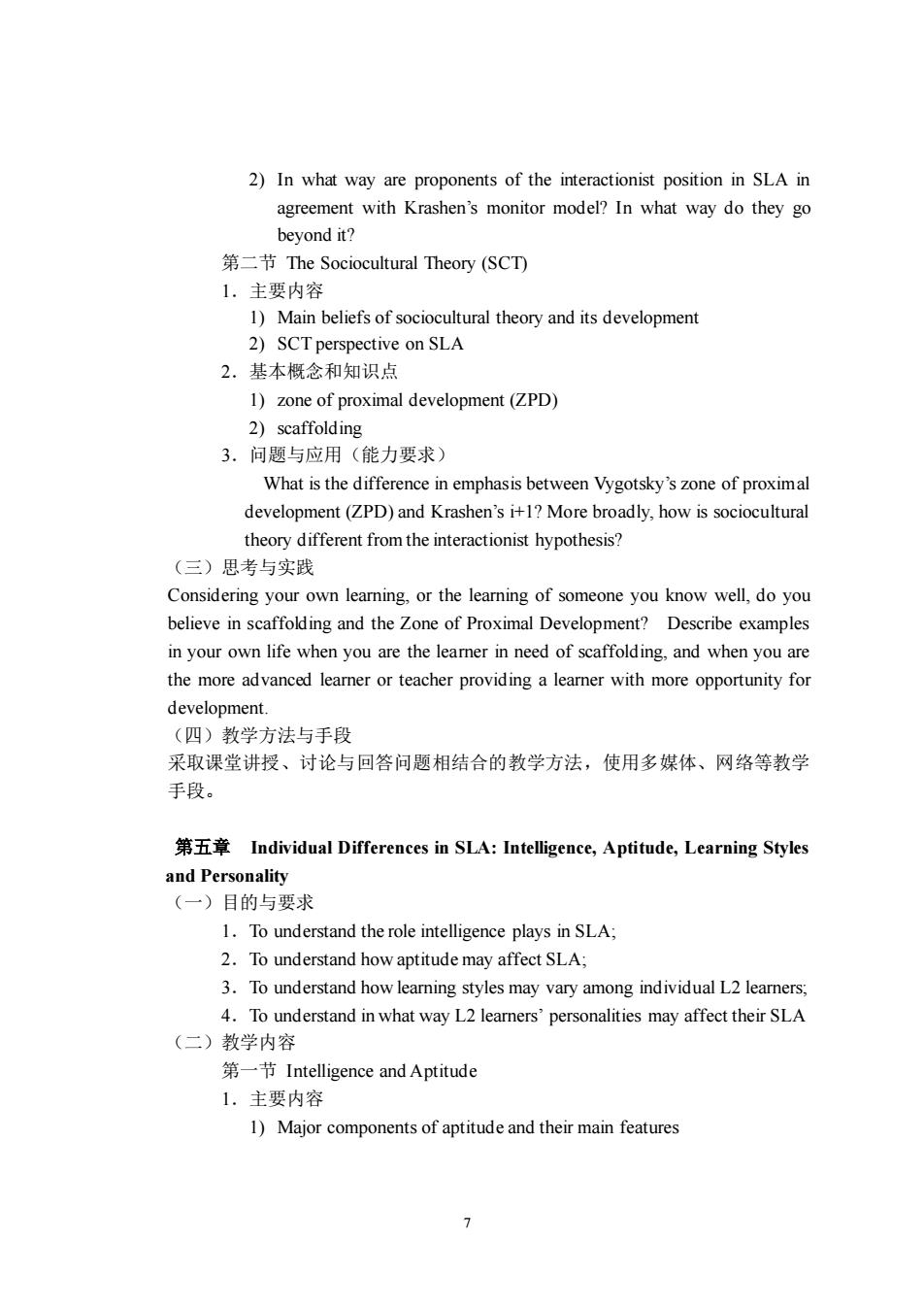
3)Probabilistic patterns of grammatical and morphological regularities 3.问题与应用(能力要求) 1)Why do connectionists have an easier time accounting for the acquisition of formulaic chunks than for the acquisition of complex syntactic structures? 2)Do you think that the brain-computer analogy is a useful metaphor for understanding SLA? (三)思考与实践 Compare and contrast the role of the environment in the behaviorist,innatist,and cognitive perspectives.Which is closest to your own view? (四)教学方法与手段 采取课堂讲授、讨论与回答问题相结合的教学方法,使用多媒体、网络等教学 手段。 第四章Explaining SLA:The Role of Interaction in SLA (一)目的与要求 1.To understand interactionist views onSLA 2.To understand sociocultural views on L2 development (二)教学内容 第一节The Interaction Hypothesis 1.主要内容 1)Interactionist perspective on LI acquisition 2)Modified input in SLA 3)Negotiation of meaning 4)The role of negotiation in language learning 2.基本概念和知识点 1)Child-directed speech 2)Foreigner talk 3)Comprehension check /Confirmation check /Clarification request/ Suggesting an answer Recasts 4)The Interaction Hypothesis 3.问题与应用(能力要求) 1)It is claimed that face-to-face interaction is not absolutely necessary for second language acquisition.What do you think?Support or refute this claim based on your own experience. 6
6 3) Probabilistic patterns of grammatical and morphological regularities 3.问题与应用(能力要求) 1) Why do connectionists have an easier time accounting for the acquisition of formulaic chunks than for the acquisition of complex syntactic structures? 2) Do you think that the brain–computer analogy is a useful metaphor for understanding SLA? (三)思考与实践 Compare and contrast the role of the environment in the behaviorist, innatist, and cognitive perspectives. Which is closest to your own view? (四)教学方法与手段 采取课堂讲授、讨论与回答问题相结合的教学方法,使用多媒体、网络等教学 手段。 第四章 Explaining SLA: The Role of Interaction in SLA (一)目的与要求 1.To understand interactionist views on SLA 2.To understand sociocultural views on L2 development (二)教学内容 第一节 The Interaction Hypothesis 1.主要内容 1) Interactionist perspective on L1 acquisition 2) Modified input in SLA 3) Negotiation of meaning 4) The role of negotiation in language learning 2.基本概念和知识点 1) Child-directed speech 2) Foreigner talk 3) Comprehension check / Confirmation check / Clarification request / Suggesting an answer / Recasts 4) The Interaction Hypothesis 3.问题与应用(能力要求) 1) It is claimed that face-to-face interaction is not absolutely necessary for second language acquisition. What do you think? Support or refute this claim based on your own experience

2)In what way are proponents of the interactionist position in SLA in agreement with Krashen's monitor model?In what way do they go beyond it? 第二节The Sociocultural Theory(SCT 1.主要内容 1)Main beliefs of sociocultural theory and its development 2)SCT perspective on SLA 2.基本概念和知识点 1)zone of proximal development(ZPD) 2)scaffolding 3.问题与应用(能力要求) What is the difference in emphasis between Vygotsky's zone of proxima development(ZPD)and Krashen's i+1?More broadly,how is sociocultural theory different from the interactionist hypothesis? (三)思考与实践 Considering your own leaming,or the learning of someone you know well,do you believe in scaffolding and the Zone of Proximal Development?Describe examples in your own life when you are the leamner in need of scaffolding,and when you are the more advanced learer or teacher providing a leamer with more opportunity for development (四)数学方法与手段 采取课堂讲授、讨论与回答问题相结合的教学方法,使用多媒体、网络等教学 手段。 Individual Differences in SLA:Intelligence,Aptitude,Learning Styles and Personality (一)目的与要求 1.To understand the role intelligence plays in SLA; 2.To understand how aptitude may affect SLA; 3.To understand how learning styles may vary among individual L2 learners; 4.To understand in what way L2 leamers'personalities may affect their SLA (二)教学内容 第-节Intelligence and Aptitude 1.主要内容 1)Major components of aptitude and their main features 7
7 2) In what way are proponents of the interactionist position in SLA in agreement with Krashen’s monitor model? In what way do they go beyond it? 第二节 The Sociocultural Theory (SCT) 1.主要内容 1) Main beliefs of sociocultural theory and its development 2) SCT perspective on SLA 2.基本概念和知识点 1) zone of proximal development (ZPD) 2) scaffolding 3.问题与应用(能力要求) What is the difference in emphasis between Vygotsky’s zone of proximal development (ZPD) and Krashen’s i+1? More broadly, how is sociocultural theory different from the interactionist hypothesis? (三)思考与实践 Considering your own learning, or the learning of someone you know well, do you believe in scaffolding and the Zone of Proximal Development? Describe examples in your own life when you are the learner in need of scaffolding, and when you are the more advanced learner or teacher providing a learner with more opportunity for development. (四)教学方法与手段 采取课堂讲授、讨论与回答问题相结合的教学方法,使用多媒体、网络等教学 手段。 第五章 Individual Differences in SLA: Intelligence, Aptitude, Learning Styles and Personality (一)目的与要求 1.To understand the role intelligence plays in SLA; 2.To understand how aptitude may affect SLA; 3.To understand how learning styles may vary among individual L2 learners; 4.To understand in what way L2 learners’ personalities may affect their SLA (二)教学内容 第一节 Intelligence and Aptitude 1.主要内容 1) Major components of aptitude and their main features